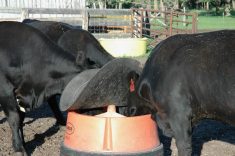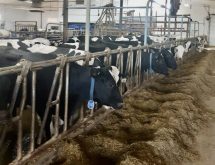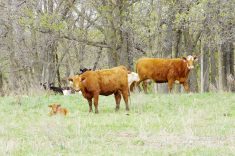One of the first things I look at with any current corn or cereal silage lab analysis is its starch level.
I then look back to see if its forage starch level has changed substantially from previous years’ silages fed to lactating dairy cows. I also look at its fibre values (ADF, NDF, NDF30) to see what kind of effective-fibre foundation we may be dealing with in any new lactation diets.
That’s because forage starch levels and effective-fibre content will significantly contribute to the overall energy density of the lactation dairy diet. Balanced together, they should maintain both good health and excellent milk production in lactating dairy cows.
Read Also

Cancer agency reclassifies another herbicide ‘probably carcinogenic’
The WHO’s cancer research agency has now put atrazine, a herbicide well known to corn growers, in the same potential-hazard category where the agency put glyphosate.
Last October, a 350-dairy cow operation started feeding its last bag of 2023 corn silage to lactating dairy cows.
Part of the issue in feeding it was that its forage analysis (see accompanying chart) revealed a relatively low neutral detergent fibre (NDF) and high digestibility as well as a grain-enriched starch level of 31 per cent and non-fibre carbohydrates (NFC) of 40.6 per cent. Subsequently, the pending TMR (total mixed ration) diet was in danger of having inadequate effective fibre (eNDF) to maintain good rumen health in the cow herd.
Six months ago, I made the best changes to the above lactation TMR diet:
- Corn silage was limited to about 10 kg dry matter (DM), to limit its starch and NFC intake — offset by alfalfa silage;
- Grain corn was severely cut back, to 3.6 kg, to do the same;
- Alfalfa haylage was used to help raise effective-forage fibre levels, but its fair levels of eNDF and high soluble protein reduced its use and effectiveness;
- Canola meal was limited to curb its vegetable oil intake; and
- Beet pulp was added at 1.5 kg.
In summary, on a dry matter basis: the forage/concentrate ratio was 63.5 per cent; eNDF, 22.5 per cent; starch, 23.2 per cent; and NFC, 39.4 per cent.
Now the first bag of 2024 corn silage has been opened up and its analysis is shockingly different (see accompanying chart) from 2023. It is much wetter. It has higher ADF and NDF values with a precipitous drop in starch of 21.1 per cent and an NFC of 34.4 per cent.

For the time being, I have yet to change the integrity of the forage base of the lactation TMR, but have increased grain corn levels to 4.5 kg to achieve a dietary starch level of about 21 per cent.
Plus, I still adhere to the maintenance of an overall 28 per cent NDF in the entire TMR with 21 per cent forage-NDF level to prevent digestive upsets or the onset of SARA (sub-clinical acidosis). As a result, current milk production hovers around 38 kg per head with 4.5 per cent milk fat.
Although the producer and I are satisfied with the current body condition score of the lactation cows — average of 3 to 3.5 — we feel that above milk performance flatlined at 135 DIMs (days in milk). We believe the starch and NFC level of the TMR is adequate, but the rate of starch digestion is lower than it should be. Since no barley is fed on this dairy farm, I suggested a load of barley be brought in to replace up to 2.5 kg of the grain corn fed.
The reason: barley grain may contain a lower amount of starch compared to corn (58 per cent to 72 per cent), but its starch is more rapidly digested in the gut and therefore its energy release is quicker.
In contrast, the endosperm of corn starch is embedded in a highly-resistant protein matrix that repels microbial invasion. Also, a significant portion of corn starch is forced into the small intestine to complete its digestion, which in some cases may limit the rumen microbes’ activities for efficient digestion of forages, grains and protein concentrates to release their essential nutrients for lactation purposes.
Dairy producers who feed barley silage to their lactation dairy herd might think that this is an only-corn-silage problem. I’ve reviewed many barley silage samples and their starch levels have also fallen (from 17 per cent down to 10-11 per cent) with higher-than-expected ADF and NDF levels. As a dairy nutritionist, I can advocate that simply feeding more barley grain to lactating dairy cows isn’t necessarily the answer in these cases — but maybe feeding some barley in combination with corn.
















